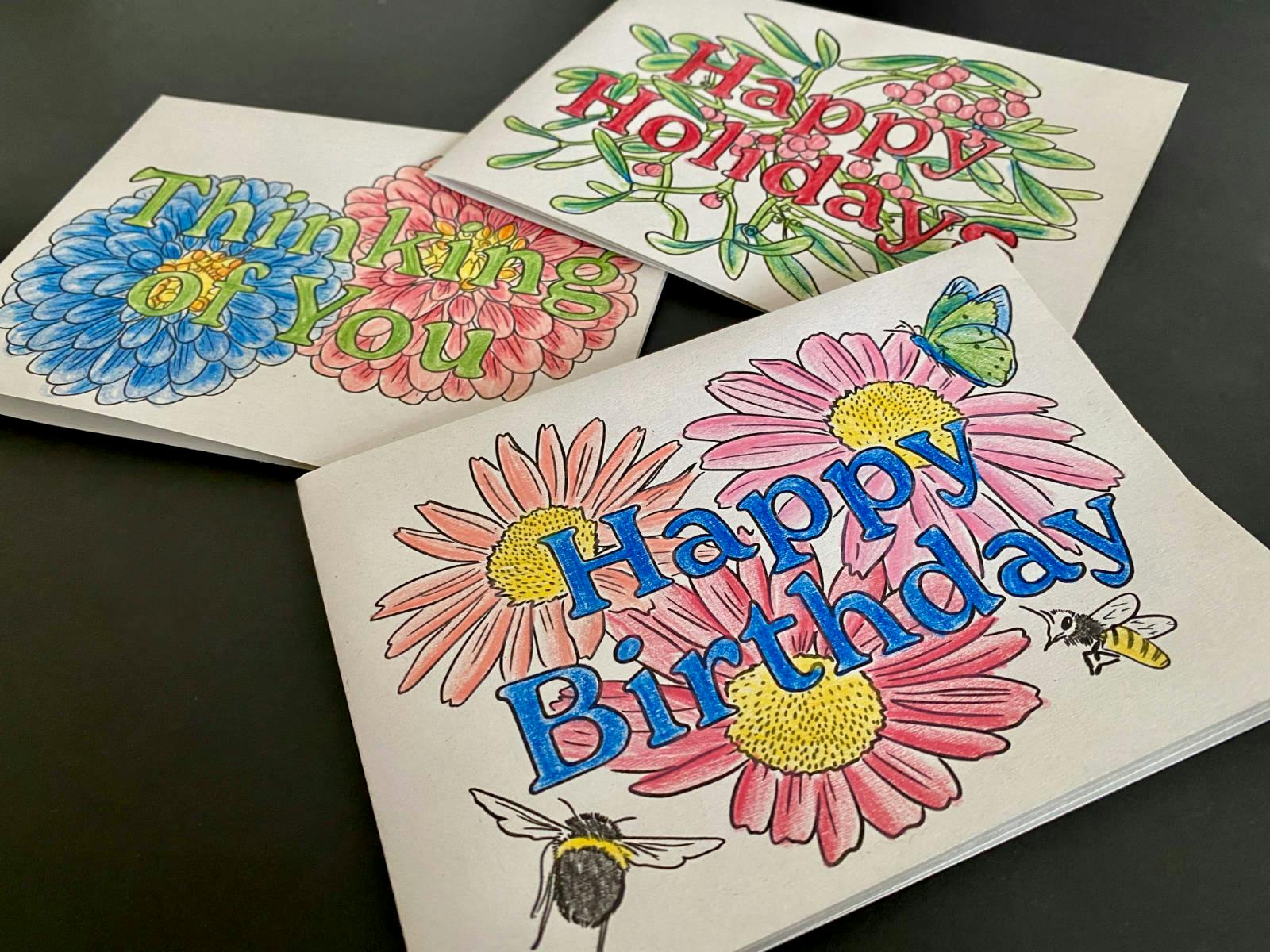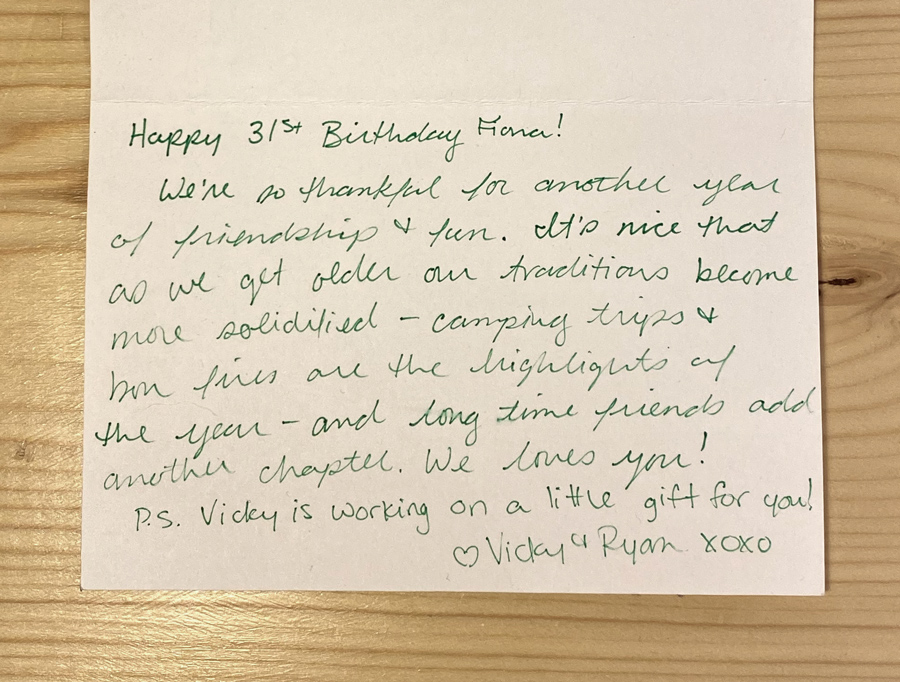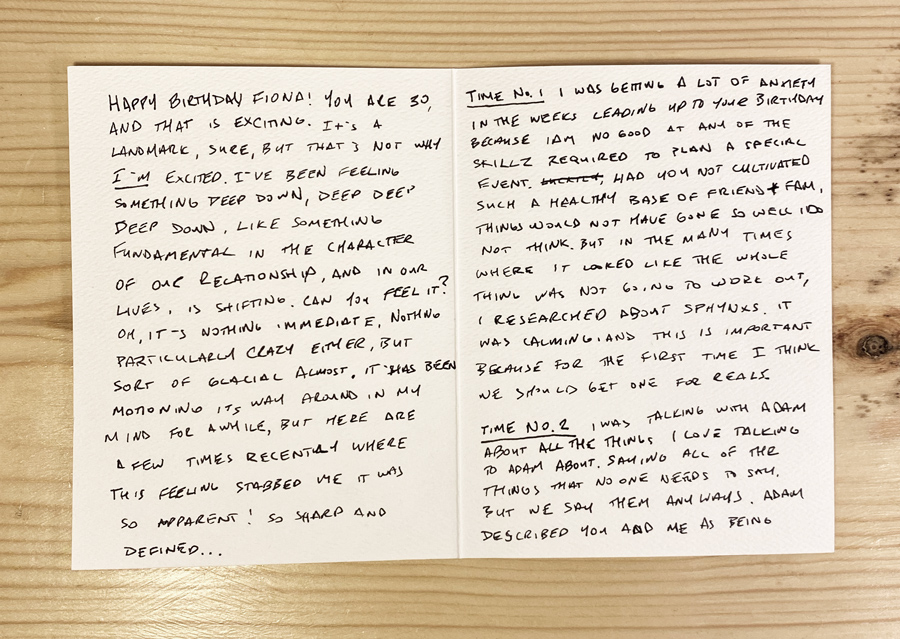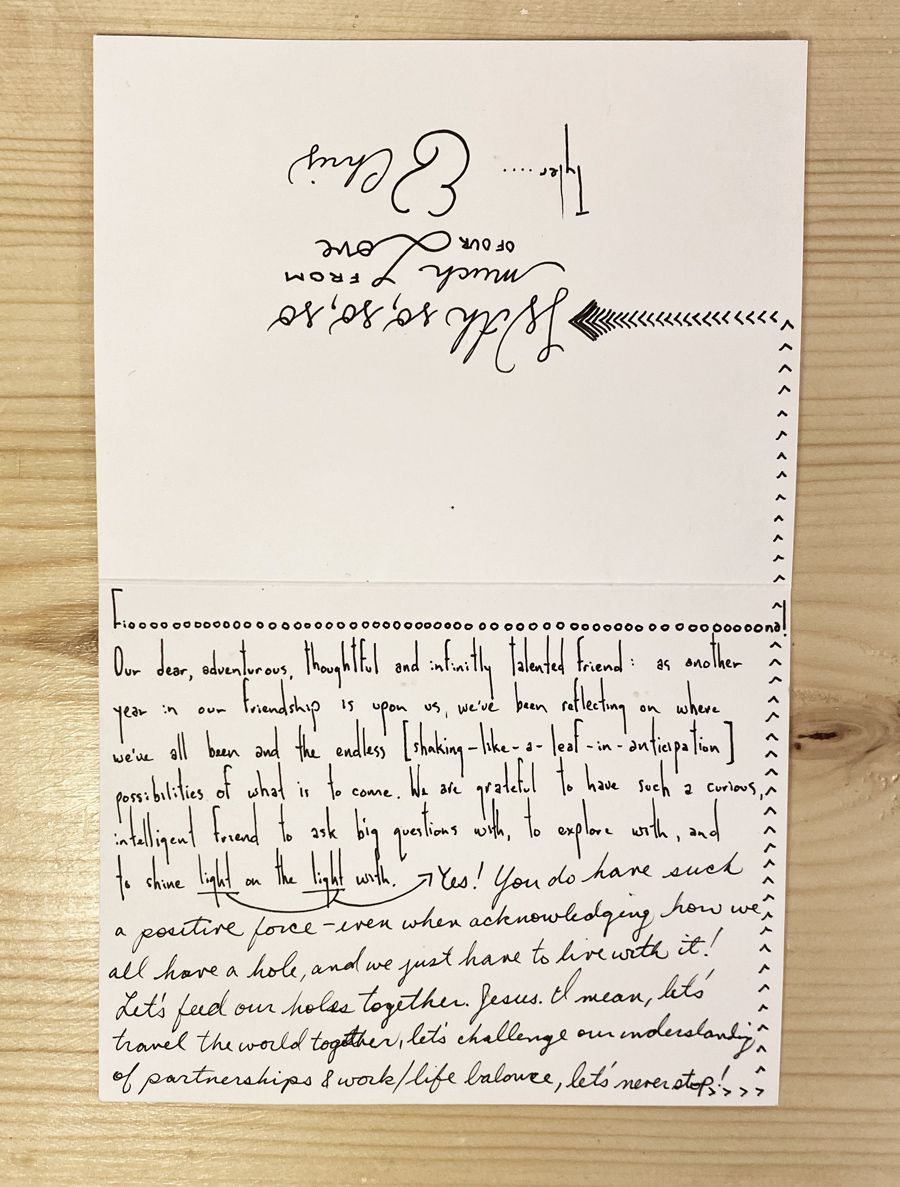How to write a good card
5 simple tips for writing more thoughtful cards for every occasion
written by fiona

published on November 8, 2022
A blank greeting card, like a blank piece of paper, can feel intimidating — what to say?! The closer you are to the recipient, and the more important the occasion, the greater the pressure to write something good. Often we’ll spend a significant amount of money on a nice design only to scribble in it quickly, minutes before rushing out the door — “Have a great day, you deserve it!” — all but ensuring our cute card will be tossed once the moment has passed.
But we all have it in us to write a good card, especially for the people we care about, and the little bit of effort it takes is always worth it.
Scroll to the end to download some free print-at-home cards that I created :)
1. Be curious & make notes
This is something you can start doing before you have a card to write. Each time you interact with a friend or loved one, take a couple of minutes afterwards and reflect on the experience. What did you enjoy about your time together? Did they say or do something that made you laugh? Was there anything they did for you (big or small) that you really appreciate — maybe they helped you carry a old fridge out of your apartment, or drove you and your cat to the vet, or listened patiently as you recounted the play by play of your work drama. What qualities or behaviours do they exhibit that you really appreciate? How do you feel after spending time with them — lighter, warmer? Approach each interaction with openness and curiosity, make a note of everything you notice, particularly the things about them that make you feel joy or delight.
We like to know that we are heard and seen by the ones we love, it helps us feel more connected to them. Our favourite people are also in a prime spot to point out the good things about us that we might not have realized ourselves — the details that are essential to who we are. The fact that you noticed and can recall these personal details will show that you have been paying attention. Which will be greatly appreciated.
Rob Walker, Author of The Art of Noticing urges us to consider these details in a recent post.
“Pay attention to those seeming “unimportant and trivial” details (the “fingerprints”) of the people you care about. And find a way to let them know you’re paying attention — to use what you’ve noticed as a way to connect.”
This practice is like creating a little gratitude journal for each person. I like to use the Notes app on my phone so it’s always handy, but voice memos also work if you need something hands-free while you’re driving. You might just want to transcribe them later, for easy reference.
Shared memories are also a great well to tap for personal messages, particularly the ones where it was just you and them. Even if the entire message is you simply recounting the memory, you’ll both have different recollections of it and your retelling might remind them of details they completely forgot. Plus, the added benefit of describing a specific memory or experience only you have shared is that no-one else will write the same message.
By making a point to pay more attention to your loved ones, you might find that you are more present in the moments you share. And presence is the best present of them all!
 A birthday card from a couple of good pals, 2017
A birthday card from a couple of good pals, 2017
2. Avoid negativity & keep it simple
This should go without saying, but if you’ve written anything even slightly defensive or aggressive, take it out. You may have unresolved issues with this person, but this is not the time nor place for that – write words you want to be remembered forever. Aim for humanity and warmth. If you tease, do so with love.
As well as staying positive, we should also try to remain focused. After all, space in a card is limited so always put clarity before creativity. Small digressions – no matter how elegant – make stories unfocused and tiring to read. The goal, in the words of product designer and self-described minimalist Dieter Rams, is less, but better leaving only what is absolutely essential to the message. Kurt Vonnegut had similar advice: Pity the readers which simply reminds us to think about who we’re writing for and to value their time.
 A 30th birthday card from my partner Matt, 2016 (we eventually adopted a stray).
A 30th birthday card from my partner Matt, 2016 (we eventually adopted a stray).
3. Be yourself, avoid clichés
You don’t need to be a “good writer” to craft a touching message, you just need to be you. That’s not as easy as it sounds, but a quick way to make your message warmer and less mechanical is by using a natural tone, as if you were speaking the words in conversation, for example “you’re” instead of “you are”.
Your words should sound like you, so try not to write things you wouldn’t say out loud, for example “stroll” might technically be the most appropriate word, but “walk” will sound more natural. With a personal note, unlike other forms of creative writing, the thesaurus is not your friend.
If you’re offering advice for the future, phrases like, Stop to smell the roses or Live each day as if it were your last are well-intentioned sentiments, but anyone could say them and if the words you’ve written sound like they were lifted from the default message in a store-bought card, you may as well not have bothered.
The goal of this exercise is to express yourself and communicate why you specifically care about the recipient, so focus on your own feelings. Your own words may share the same sentiment as the cliché, but the difference is that only you will have said them. Writing in a human tone and describing how you really feel will help make your words sincere and engaging. Or as T.S. Elliot once noted: If you write what you yourself sincerely think and feel and are interested in, you will interest other people.
 I’ve kept a lot of cards from these two as they were always so playful and sweet.
I’ve kept a lot of cards from these two as they were always so playful and sweet.
4. Set your mind
When it’s time to write the card, no matter the occasion, try to set aside 15-30 minutes of relaxed downtime. You usually don’t have much space in a card, but the quality of the message will be directly linked to the mental state you wrote it in — they’ll be able to tell if it was a last-minute-panic. Plan to write when you know you’ll have a quiet moment alone or when you find yourself in a mind-wandering situation — maybe on the commute to work, or before you go to bed.
Consider what this person means to you, the impact they have on your life – past, present, future — and why exactly you enjoy their company. Consult your notes, if you have some.
5. Try making it yourself
Pretty cards are great, but a simple piece of paper or cardstock will do, especially if you’re taking the time and effort to write something thoughtful. As with our human connections, it’s really the stuff inside that matters. Plus, handmade cards are one-of-a-kind ✨
Here are a few prompts to get you started:
- One thing I really admire about you is...
- I really appreciated it when you...
- I don’t know if you know this about yourself, but you’re really good at...
- A fond memory I have of you from this past year is...
- I just want to say thank you for...
- If I were describing you to someone who’d never met you I would say...
- I’m so happy we’re friends, and always look forward to seeing you because...
- I think your most underrated quality is...
- If I had to write a 7-word bio for you, it would say...
I’ve created 3 print-at-home cards, free to download, in both A4 and US Letter sizes. They’re intended to be colored by hand — another opportunity to show you’ve put in a bit more effort than the average card-giver — which IMO counts more than the thought.
A4
Letter
There are so few opportunities to tell our favourite people how much they mean to us and why, specifically, we love them. A blank card — be it for a birthday, wedding, or just because — is one of those opportunities, and it’s so often overlooked.
written by fiona
Questions? We’re here to help.
Visit support or Give us feedback
We value your words.
Updates, gifting tips, and promos
— an occasional newsletter